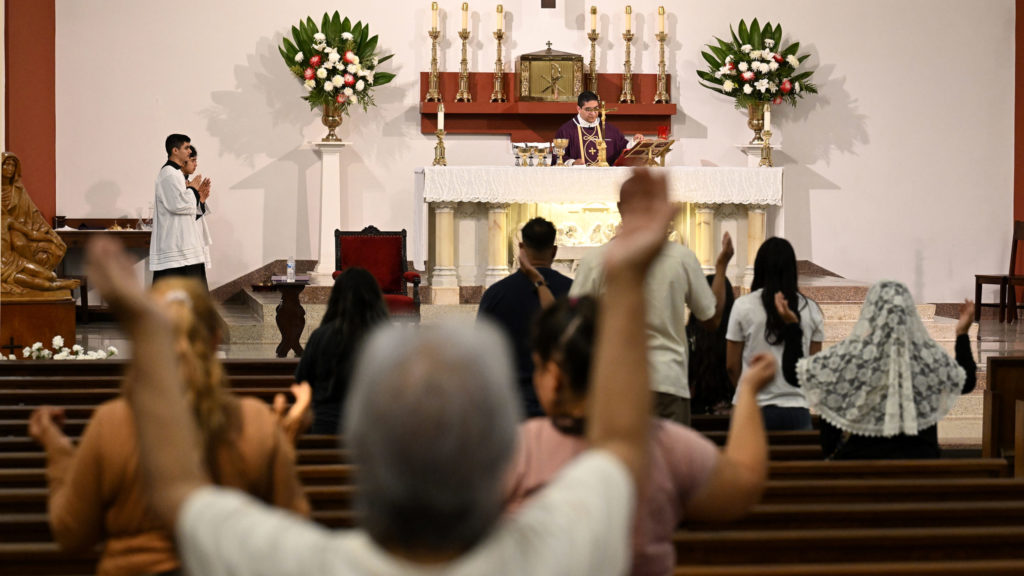Standing single file, a line of people formed halfway through Mass to bring white carnations to the altar at St. Agnes Church near downtown LA.
Moments earlier, they had sung the words of the responsorial psalm, “Out of the depths, I cry to you Lord” (Psalm 130) and listened to the Gospel reading of Christ raising Lazarus from the dead, assuring sisters Martha and Mary that “your brother will rise.”
Now, they waited to place their flowers — each representing a loved one lost to suicide — beneath a reproduction of Michelangelo’s “Pietà,” the famous sculpture depicting Mary holding Jesus after he’d been taken down from the cross.
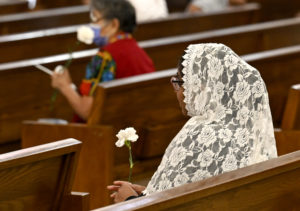
The look of agonizing grief mixed with divine acceptance on her face seemed to express what this “Mass of Remembrance and Healing after Suicide” on Sept. 7 was all about: to not only mourn those who had passed, but to strengthen those who still mourn them.
Like most of those at the bilingual Mass, which coincided with National Suicide Prevention Month, Dwain Miller had experienced suicide firsthand; three times, actually. He knows well the uniquely difficult grieving process, where more typical feelings of pain and loss are often accompanied by ones of guilt, anger, and shame. When a friend took his life on Labor Day 1991, it burdened Miller for years with the type of “unanswered questions” that St. Agnes associate pastor Father Daniel Lopez referred to in his homily — questions that can haunt a person for decades.
“You’re angry with them, you know, why weren’t you able to talk to us,” said Miller, who works with the archdiocese’s restorative justice ministry and who, until recently, worked as a chaplain at the Dorothy Kirby Center in Commerce, an LA County juvenile rehabilitation facility. It’s those unanswered questions, Miller said, that “can really make it hard to ever really say good-bye.
“You also look at yourself, you ask why wasn’t I able to see it? Did I do enough? Could I have made one more call, visited one more time, said just the right thing?”
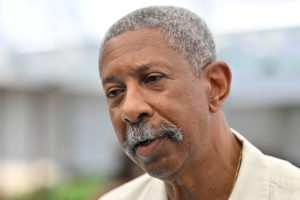
It was the struggle with those same feelings that first gave Jennifer Usyak the idea for this Mass — believed to be first of its kind in the LA Archdiocese — and a reception that would make available resources for mental health, suicide prevention, and bereavement support. After learning that a family member died by suicide two years ago, Usyak, who describes herself as having a strong faith, said she was “surprised to find how rattled, how deeply traumatized I was by it.”
Usyak said suicide presents a "complex type of grief," one that left her searching for assistance in finding answers. After attending a similar Mass in Orange County, her search led her to a few people, including licensed clinical social worker Alicia Arreguin, who Usyak knew was active in mental health ministry at St. Agnes, located near the USC campus. Alicia then approached St. Agnes pastor Father Luis Espinoza about hosting one at the church.
“I told him we wanted to make this Mass an invitation to those who are hurting, a Mass not only to remember but for healing,” Arreguin said. “He said, ‘Sure, go for it.’ ”
Jeanette Gonzalez Seneviratne, of the LA Archdiocese’s Office of Life, Justice, and Peace, also got involved. The trio approached organizations that could get involved: suicide crisis lines and prevention services, bereavement and support groups, and mental health organizations.
Bereavement minister Cathy Narvaez, who runs a support group at St. Mary of the Assumption Church in Whittier, and spoke with people after the Mass, said those dealing with suicide are in need of their own, specific support group. Hers makes a point of waiting at least three months after their loss before they start.
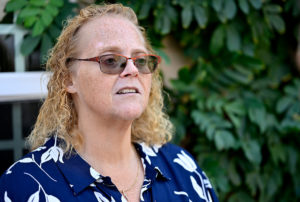
“There’s so much, the shock, the feelings of guilt,” she said. “It’s so much to process, the body just can’t do it all before three months. Once we do work with them, we show them how to get through the grieving process so they can live again.”
At the Mass, a big smile appeared on Dwain Miller’s face as he spoke with Narvaez. Back when his friend died, he felt as if the Church “was less than welcoming, as if the Church wasn’t a place for me to go to grieve.”
“That’s why this Mass was so good, so special, it brought back a lot of memories and tears, but allowed me to say good-bye. It allowed me to feel like the Church acknowledged my pain. I didn’t feel that way back then.”
Those of a certain age can remember a time when the Church took a more juridical approach to its teaching that suicide was a mortal sin, sometimes not allowing those who died by it to have funeral Masses in Catholic churches.
“The Church has changed big time and praise God for that,” said Lopez, who had a friend die by suicide while Lopez was studying to be a priest. “One of the conditions of a mortal sin is that you commit it of your own free will. The Church now recognizes that with conditions such as depression, you don’t have free will. Modern psychology has helped transform the Church’s understanding of this.”
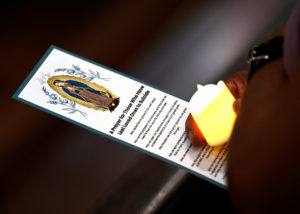
Seneviratne, who heads the archdiocese’s “Caring for the Whole Person” initiative, believes it’s important that people “know that the Church is walking with you in this pain, that we have taken a totally different approach.”
Within the archdiocese, Seneviratne’s office offers to connect those interested with the necessary referrals, resources, or mental health counseling, including within their own parish.
Such resources, Lopez believes, can represent “a beacon of light for those who need it.”
“These kinds of Masses show people they’re not alone,” he said. “Perhaps there was someone here today who needed to hear that, see it, to feel that.”
